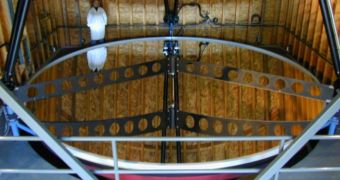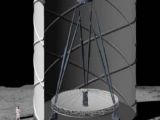Liquid mirrors, discovered not long ago, provide the best results at lower costs. They generally require the heavy mercury material to build, but a new approach may enable researchers to place giant versions of such devices even on the Moon.
Another one of those science-fiction visions will soon come true, namely that of having large telescopes placed on our natural satellite. And not just any telescope, but liquid mirror ones, of which only a few have been produced even on Earth.
The basic idea behind all this is quite simple, as Ermanno F. Borra, a physics professor from Laval University's Optics Laboratory in Quebec, Canada explains: “Isaac Newton knew that any liquid, if put into a shallow container and set spinning, naturally assumes a parabolic shape – the same shape needed by a telescope mirror to bring starlight to a focus. This could be the key to making a giant lunar observatory. It doesn't need to spin very fast. The rim of a 4-meter–diameter mirror – the largest I've made in my lab – travels only 3 miles per hour, about the speed of a brisk walk. In the low gravity of the Moon, it would spin even slower.”
The majority of the existing liquid mirror telescopes had their mirrors built from mercury, which remains in this state at normal temperatures and reflects back approximately 75% of the received light, about as much as silver does. Such a device, which is larger than a traditional, fixed one, costs only about a sixth of the expenses a regular telescope entails, which makes it a lot more viable. The problems of its lunar placement lie in transporting the extremely heavy and expensive mercury, in powering the device and in the fact that it would surely evaporate under the low gravity conditions of the moon.
However, solutions have been found for all these aspects. Mercury has been replaced with a class of organic compounds called ionic liquids, which are way less dense than mercury (somewhat denser than regular water). According to Borra, “Ionic liquids are basically molten salts. Their evaporation rate is almost zero, so they would not vaporize in the lunar vacuum. They can also remain liquid at very low temperatures.” He and his team are now trying to obtain such liquids that would stay molten even at temperatures as low as liquid-nitrogen.
These liquids don't have a very good reflective capacity in themselves but, upon spinning, they can be covered with an extremely thin layer of silver (of about 50-100 nanometers). The oddest part is that, while the silver spreads, because it's so thin, it solidifies, forming a perfect mirror. The main advantage of liquid mirrors is that they don't require all that heavy gear for tilting, since they cannot be moved (otherwise the mirror shape would break and the liquid would spill). This makes them even more suited for carrying onto the moon or any other place they may be needed.
The eventual tilting effect would be compensated by installing additional mirrors that could be pointed so as to mimic the tilting effect by transmitting the light they capture to the main liquid mirror. Also, the strategic placement of the telescope anywhere else but the lunar poles would cause the moon's spinning to ensure the covering of a reasonable portion of the sky. While it could be placed in a lunar crater from its dark side, solar panels built in the immediate vicinity, on a mountain peak from the sunny side, could provide more than enough power in order to fuel the device. Aside from all the heavy gearing a regular, tilting telescope would require, this way, the built-in powering gear could also be subtracted from the carry and installation equation.
As Borra claims, “All you'd need is the liquid-mirror container, which might be an umbrella-like device that self-deploys, plus a nearly frictionless superconducting bearing and its drive motor.” All the needed materials for the entire lunar telescope of 20 meters across would weigh just several tons, and carrying them to the Moon would pose no difficulty even for a single mission of Ares 5 in the 2020s. Liquid mirror telescopes of that time might already measure 100 meters in diameter – bigger than a football field.
“A mirror that large could peer back in time to when the universe was very young, only half a billion years old, when the first generation of stars and galaxies were forming,” explains Borra enthusiastically. “Potentially more exciting is pure serendipity: new things we might discover that we just don't expect.”

 14 DAY TRIAL //
14 DAY TRIAL // 
